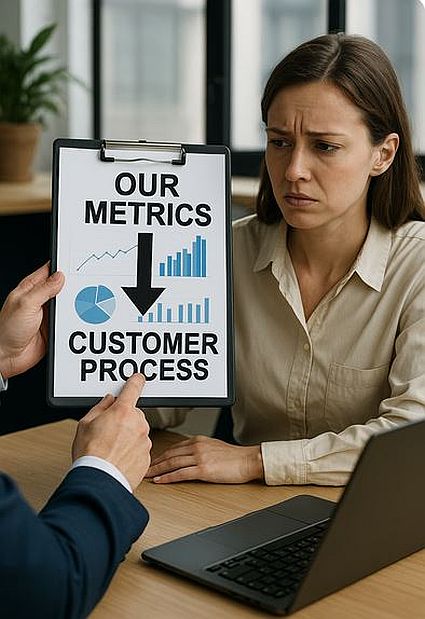As revenue operators, our job is to find and close customers. Whether it’s net new customers, retention/renewal, expansion. We measure our success based on hitting our revenue and profitability goals.
Even when we claim to be customer centric, too often, we organize our GTM motions and measure our success in ways that make customers collateral damage, or worse, a means to our ends.
We don’t start with the customer buying journey. We don’t start by helping them understanding and defining their problems. We cast everything in our terms and contexts. We organize the customer engagement strategy around our GTM process, bow ties, staged pipeline processes. Every interaction and every metric we use to track those interactions are based on us, where we are in the process, our timelines, metrics, and goals.
We attempt to rush them through our steps, because our playbooks mandate this, and we measure ourselves on those activities. We try to hold them accountable to our time lines, “I need this by the end of the quarter,” rather than trying to understand where they are and what they are trying to achieve.
Our processes are not designed for our customers. They are designed to scale our GTM goals. To drive consistent execution across our organizations. To generate the data we feed into our dashboards. And they would probably work if it weren’t for those “damn customers!”
Our KPIs are for us and our operations. They have nothing to do with how the customer wants to proceed forward, what they need to learn or achieve, what risks they need to manage. They have nothing to do with helping the customer solve their problem. They have nothing to do with building relationships and trust.
And the customer feels this pressure. They are victims or our outreach sequences, social engagement. They must cope with scripted conversations that help the seller but don’t help the buyers. They sit through endless demonstrations about our products and how great we are, because those are important to us. “Here’s a comparison of our features and functions! Here’s our corporate vanity chart showing all our customers, our investors, and our market cap!” We inflict these on them because our playbooks and KPIs tell us we have to do this.
Even our “empathy” is templated. We are taught the right words and phrases to move customers through our pipelines. Terms like, “I totally understand where you are coming from….” come from our playbooks, not from genuine understanding or caring. But when we’ve never taken the time to really know our customers, our ability to be truly empathetic is limited.
We see how customers respond—rather DON’T RESPOND–to these manipulations. They are meaningless to them, and they will not waste their time.
And despite this, our solution is to double and triple down, adjusting the KPI math, trying to achieve our goals.
What if we tried to “Flip The Script?” (Thank you Becc Holland) Rather than inflicting our GTM metrics and KPI, trying to enforce sales and customer compliance, what if we looked at it differently?
A few thoughts:
- We need to start with the customer journey/buying process, not ours. While our sales process is critical in helping us understand, we can’t make our process the limiter, rather make it a way we can accelerate understanding the customer process. Listening and learning from them, how are they making sense of the problem, what are they thinking, who’s involved, what art the hurdles, where are they shaky, how can we help them? Rather than “where are they in the pipeline,” perhaps we start thinking “where are they in their internal process, how can we help them in what they might need next?”
- Flip the metrics. Rather than tracking them through our metrics/KPIs, why don’t we start measuring mutual progress. Rather than looking at MQLs, what if we measured “How are we generating curiosity?” Rather than Net Promoter Score, we look at “Did we help the customer achieve what they needed to achieve?” Rather than tracking our activity metrics, dials, outbounds, social, meetings, demos; what if we started asking, “Did this interaction help the customer gain greater clarity, did it help them generate greater internal momentum in their change initiative, are we helping them get closer to where they need to go?”
- Change our timeframe to align with the customers’ timeframes. We operate on a weekly, monthly, quarterly cadence. Our customers are in it for the long term, they want sustainable results, growth, constant improvement. They want to be aligned with people/organizations that share this goal and want to help them. By looking at the longer term, we win now and in the future. We develop and grow trust.
- Make our processes flexible, not rigid. Our customers don’t have a playbook. And our playbooks are meaningless to them. They want a partner to help them develop and structure their process or project plan. They want something that focuses on what they need to achieve, not what we are measuring. Again, our sales processes are a starting point in doing this, but they are not the end.
In everything we do in our GTM strategies, our processes, our metrics, there is one fundamental question we must challenge ourselves with:
“Does this serve the customer–or does this just serve our operating model?”
Afterword: This is the AI generated discussion of this post. It’s pretty good, about a B+ (but I’m a tough grader). Enjoy!

Leave a Reply